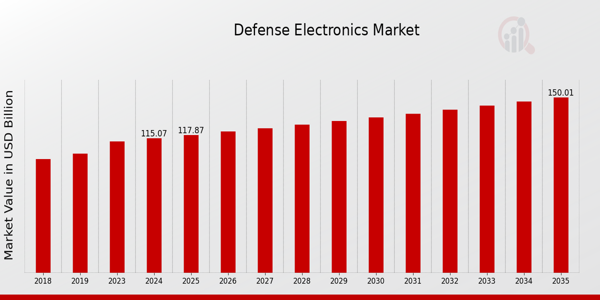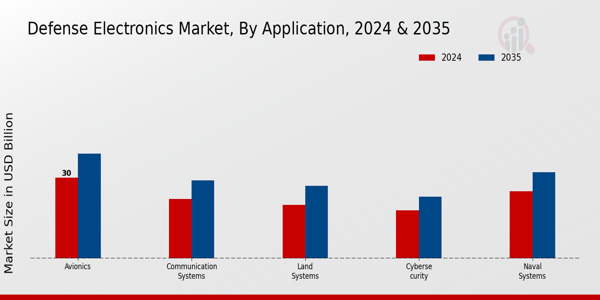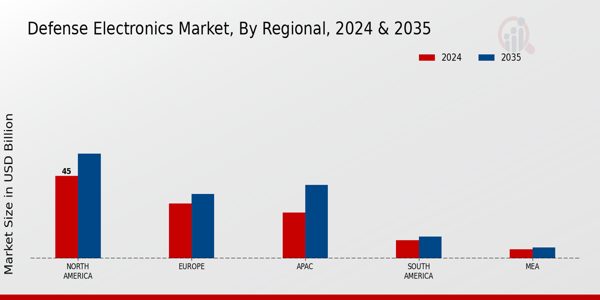Defense Electronics Market Overview
Defense Electronics Market Size was estimated at 112.33 (USD Billion) in 2023. The Defense Electronics Market is expected to grow from 115.07 (USD Billion) in 2024 to 150 (USD Billion) by 2035. The Defense Electronics Market CAGR (growth rate) is expected to be around 2.44% during the forecast period (2025 - 2035).
Key Defense Electronics Market Trends Highlighted
Notable trends are changing the landscape of the defense electronics market. The growing geopolitical tensions in different regions, which push countries to improve their military capabilities, are a major market driver. Globally, nations are making large investments in cutting-edge defense technologies, such as communication, surveillance, and electronic warfare systems.
The need for advanced defense electronics is being driven by the increased emphasis on modernization and the requirement for better defense mechanisms. Furthermore, there is a noticeable trend toward the integration of automation and artificial intelligence into military systems as the nature of battle changes.
It is anticipated that this trend would enhance decision-making and operational effectiveness. Additionally, more countries are supporting the creation of domestic military capabilities, which gives local businesses the chance to innovate and satisfy regional demands.
A significant potential also arises from the growing focus on cybersecurity, since safeguarding defense networks and electronic systems becomes critical in the face of growing cyberthreats. Partnerships between technology firms and defense contractors have also increased recently, opening the door for increased innovation and knowledge sharing.
The demand for compatible electronics is being driven by the growing trend of international joint military exercises, which highlights the necessity of interoperable defense systems.
All things considered, the growing emphasis on cutting-edge technology, along with regional defense requirements and strategic alliances, is driving the defense electronics market in the direction of a more technologically advanced and integrated future.

Source Primary Research, Secondary Research, MRFR Database and Analyst Review
Defense Electronics Market Drivers
Increasing Geopolitical Tensions
The Defense Electronics Market is significantly influenced by rising geopolitical tensions across various regions. Governments worldwide are increasingly focused on bolstering their defense capabilities due to perceived threats from neighboring countries and non-state actors.
For instance, according to the Peace Index, military expenditure has shown an upward trend, with the total expenditure of the military in 2021 estimated at 2 trillion USD, reflecting a substantial increase from previous years.
Organizations like NATO have also reported enhanced defense budgets among member countries to address security concerns. The necessity for advanced defense electronics in military applications, including missile systems, surveillance, and communication, aligns with this heightened focus, thus driving market growth.
Countries like the United States and China are leading in maximizing their defense technologies, with significant investments in modernizing their defense electronics capabilities.
This ongoing situation accentuates the crucial role of the Defense Electronics Market by ensuring that defense forces have access to sophisticated electronic warfare systems, advanced sensors, and secure communication infrastructure.
Advancements in Military Technology
Rapid advancements in military technology significantly contribute to the growth of the Defense Electronics Market. The continuous push for Research and Development (R) in defense electronics results in developing cutting-edge technologies like unmanned aerial vehicles (UAVs), cyber defense systems, and electronic warfare solutions.
According to data from the United States Department of Defense, around 2.5% of its budget is devoted to technology development, emphasizing the commitment to innovation. Similarly, countries in the Asia-Pacific region are making considerable investments in defense technology to enhance their military capabilities, targeting a combined defense spending of over 500 billion USD by 2025.
Consequently, the integration of advanced electronics equips defense forces to maintain a strategic edge over potential adversaries. This technological evolution means that the Defense Electronics Market is on an upward trajectory, propelled by the ongoing demand for modern electronic systems and solutions.
Growing Cybersecurity Concerns
In an increasingly digitized world, cybersecurity has become a paramount concern for national defense systems. The rising number of cyber threats targeting military and defense infrastructures drives the demand for advanced electronic defense systems capable of thwarting these attacks.
A report from the United Nations Office for Disarmament Affairs estimated that cyberattacks against defense installations rose by 50% over the last two years. As the Defense Electronics Market encompasses electronic warfare systems, secure communication technologies, and cyber defense mechanisms, this surge in cyber threats necessitates heightened spending in these areas.
Various nations, including the United States and members of the European Union, are actively enhancing their cybersecurity frameworks to protect against potential breaches, further emphasizing the importance of the Defense Electronics Market in safeguarding national interests.
Defense Electronics Market Segment Insights
Defense Electronics Market Application Insights
The Defense Electronics Market showed significant potential, particularly in its application segment, which is comprised of critical areas such as Avionics, Naval Systems, Land Systems, Cybersecurity, and Communication Systems.
Avionics held a major position in this market, valued at 30.0 USD Billion in 2024 and projected to expand to 39.0 USD Billion by 2035, emphasizing its crucial role in modern military operations that relied on advanced technology for air defense and navigation.
Naval Systems also played a pivotal role, valued at 25.0 USD Billion in 2024, and expected to increase to 32.0 USD Billion in 2035, reflecting the ongoing investments in maritime security and naval warfare technologies.
Meanwhile, Land Systems, another vital application, maintained a strong presence with a market valuation of 20.0 USD Billion in 2024, growing to 27.0 USD Billion by 2035, showcasing the ongoing demand for ground defense capabilities in varied combat scenarios.
Cybersecurity, valued at 18.0 USD Billion in 2024 and expected to reach 23.0 USD Billion by 2035, becomes increasingly important as cyber threats escalate, requiring robust defenses to protect national security infrastructure.
Communication Systems also held significant value, with 22.07 USD Billion in 2024 and projected to grow to 29.0 USD Billion by 2035, highlighting the essential need for secure and reliable communication channels in defense operations.
The increasing need for sophisticated defense technologies across these applications indicates ongoing investments and innovations in the Defense Electronics Market, demonstrating its critical role in enhancing national and security frameworks.
The focus on technological advancements and the need for interoperability among different defense systems drives the evolution of this market, with each application showcasing its importance based on valuation and growing operational needs.

Source Primary Research, Secondary Research, MRFR Database and Analyst Review
Defense Electronics Market Technology Insights
The market encompasses several key areas, including Electronic Warfare, Radar Systems, Electro-Optical and Infrared Systems, Sensors, and Computing and Processing Systems. Electronic Warfare is crucial for information superiority on the battlefield, allowing military forces to disrupt, manipulate, or control enemy communications and radar systems.
Radar Systems play an essential role in surveillance and target detection, significantly contributing to national security. The Electro-Optical and Infrared Systems provide advanced sensing capabilities that enhance situational awareness, crucial for real-time decision-making.
In addition, Sensors are integral for gathering intelligence, while Computing and Processing Systems enable effective data analysis and mission planning.
As technology advances, the integration of artificial intelligence and machine learning into these systems presents growth opportunities, although challenges related to cybersecurity threats persist. Overall, the Defense Electronics Market showcases a strong growth trajectory, driven by increased defense spending and technological innovation across these areas.
Defense Electronics Market End Use Insights
The Defense Electronics Market revenue is influenced by several key End Use components, primarily encompassing Military, Defense Contractors, Government Agencies, and Homeland Security. The Military sector plays a crucial role as it maintains a majority holding in the market, driven by ongoing modernization programs and the incorporation of sophisticated electronic systems.
Defense Contractors also significantly contribute, collaborating with governments to enhance defense capabilities through innovative technologies. Government Agencies are pivotal as they fund and regulate defense initiatives, ensuring the alignment of defense strategies with national security objectives.
Homeland Security has gained importance due to rising security threats, reinforcing the need for advanced electronic solutions to monitor and respond to potential risks.
Overall, the Defense Electronics Market segmentation reveals strong growth opportunities, supported by technological advancements and heightened defense spending globally, maintaining a steady pace in the years leading up to 2035.
Defense Electronics Market Component Insights
The Defense Electronics Market is poised for significant growth, particularly in the Component segment, which plays a critical role in military applications. Key components include Radars, which enhance surveillance and target detection capabilities, and Electronic Warfare Systems, crucial for countering threats in real-time.
Sensors have become increasingly vital in gathering intelligence and operational data, while Communication Equipment ensures reliable information exchange across defense platforms. Command and Control Systems are integral for effective management and coordination of military forces.
Together, these components contribute substantially to the overall landscape of the Defense Electronics Market segmentation, highlighting the importance of advanced technology in modern warfare, driven by the need for enhanced operational efficiency and strategic superiority.
As defense spending rises, these components are expected to dominate the market, presenting both growth opportunities and challenges in terms of technological advancements and integration. Market growth is further supported by increased geopolitical tensions and the ongoing pursuit of superior defense capabilities.
Defense Electronics Market Regional Insights
The Defense Electronics Market revealed significant regional dynamics with North America leading the way, holding a valuation of 45.0 USD Billion in 2024, projected to grow to 57.0 USD Billion by 2035. This region was crucial due to substantial investment in advanced technologies and defense systems.
Europe followed with a valuation of 30.0 USD Billion in 2024 and expected growth to 35.0 USD Billion by 2035, stemming from the ongoing modernization of defense capabilities. The Asia-Pacific (APAC) market, valued at 25.0 USD Billion in 2024, is set to expand significantly to 40.0 USD Billion by 2035, driven by rising geopolitical tensions and increased defense budgets.
Meanwhile, South America, although smaller, was valued at 10.0 USD Billion in 2024 and is anticipated to reach 12.0 USD Billion by 2035, reflecting emerging defense needs in the region.
The Middle East and Africa (MEA) represented a valuation of 5.07 USD Billion in 2024, with a projection to 6.0 USD Billion by 2035. This segment, although less dominant, is gaining importance as regional conflicts push nations to enhance their defensive technologies.
Collectively, these insights depicted substantial growth opportunities across the Defense Electronics Market segmentation, closely related to regional security needs and technological advancements.

Source Primary Research, Secondary Research, MRFR Database and Analyst Review
Defense Electronics Market Key Players and Competitive Insights
The Defense Electronics Market is characterized by a dynamic and competitive landscape where technological advancements and strategic alliances play a pivotal role.
The sector encompasses a wide range of products and solutions including communication systems, surveillance systems, and electronic warfare equipment, driven by the increasing demand for enhanced operational capabilities among defense forces worldwide.
In this market, companies are continuously innovating to deliver cutting-edge technologies that meet the evolving security challenges. The competitive insights reflect a keen focus on partnerships, mergers, and acquisitions, with organizations striving to enhance their product offerings and expand their geographical reach.
As nations prioritize security and defense budgets, the competition intensifies, presenting both challenges and opportunities for firms operating within this sector. Rockwell Collins has established itself as a strong player in the Defense Electronics Market, leveraging its extensive experience in advanced avionics and communications systems.
The company's strength lies in its robust portfolio of high-performance aerospace and defense solutions, which cater to various military applications. Rockwell Collins has built a significant market presence by focusing on innovation and customer-centric solutions, enabling it to meet the unique needs of its clients effectively.
Its commitment to research and development facilitates continuous improvement of its technologies, ensuring reliability and efficiency in mission-critical scenarios. With a network and strong relationships with defense agencies, Rockwell Collins has successfully positioned itself as a trusted partner in providing state-of-the-art defense electronics.
Hensoldt is another key player in the Defense Electronics Market, known for delivering high-quality sensor solutions and electronic warfare systems. The company specializes in the development of advanced radar, optronics, and electronic surveillance products, which fortify situational awareness and enhance combat capabilities for armed forces around the world.
Hensoldt's strong presence in the defense sector is underpinned by its commitment to innovation and cybersecurity, providing tailored solutions that meet the demands of modern warfare. Through strategic mergers and acquisitions, Hensoldt has expanded its technological capabilities and market foothold, enabling it to thrive amidst competitive pressures.
The focus on research and collaboration with international partners has further solidified its position as a leader in the defense electronics domain, making it a pivotal entity in shaping the future of defense technology.
Key Companies in the Defense Electronics Market Include
- Rockwell Collins
- Hensoldt
- BAE Systems
- Rheinmetall
- Elbit Systems
- Northrop Grumman
- Leonardo
- L3Harris Technologies
- Lockheed Martin
- Kongsberg Gruppen
- Hewlett Packard Enterprise
- Raytheon Technologies
- Thales Group
- Saab
- General Dynamics
Defense Electronics Market Developments
The Defense Electronics Market has seen dynamic developments recently, particularly with companies such as Northrop Grumman and Raytheon Technologies reporting significant contract wins amid increasing defense budgets across various nations.
In October 2023, Elbit Systems announced a series of upgrades to their electronic warfare systems, enhancing capabilities for various platforms. BAE Systems and Rheinmetall have been collaborating to integrate advanced technologies into defense platforms.
Mergers and acquisitions are notable; for instance, in March 2023, L3Harris Technologies completed its acquisition of a smaller technology firm specializing in satellite communications, strengthening its position in the defense sector.
The market is also witnessing a trend of increased investment in Research and Development, aiming to innovate and enhance electronic warfare and surveillance capabilities. The growth in market valuation is fueled by heightened defense expenditures from nations focusing on modernization and readiness.
Over the past two years, significant defense contracts and partnerships have reshaped alliances in the Defense Electronics Market, reflecting the strategic maneuvering of companies like Lockheed Martin, Thales Group, and Kongsberg Gruppen, fortifying their offerings in a competitive landscape.
Defense Electronics Market Segmentation Insights
- Defense Electronics Market Application Outlook
- Avionics
- Naval Systems
- Land Systems
- Cybersecurity
- Communication Systems
- Defense Electronics Market Technology Outlook
- Defense Electronics Market End Use Outlook
- Military
- Defense Contractors
- Government Agencies
- Homeland Security
- Defense Electronics Market Component Outlook
- Radars
- Electronic Warfare Systems
- Sensors
- Communication Equipment
- Command and Control Systems
- Defense Electronics Market Regional Outlook
- North America
- Europe
- South America
- Asia Pacific
- Middle East and Africa
Defense Electronics Market Report Scope
|
Report Attribute/Metric
|
Details
|
|
Market Size 2023
|
112.33(USD Billion)
|
|
Market Size 2024
|
115.07(USD Billion)
|
|
Market Size 2035
|
150.0(USD Billion)
|
|
Compound Annual Growth Rate (CAGR)
|
2.44% (2025 - 2035)
|
|
Report Coverage
|
Revenue Forecast, Competitive Landscape, Growth Factors, and Trends
|
|
Base Year
|
2024
|
|
Market Forecast Period
|
2025 - 2035
|
|
Historical Data
|
2019 - 2024
|
|
Market Forecast Units
|
USD Billion
|
|
Key Companies Profiled
|
Rockwell Collins, Hensoldt, BAE Systems, Rheinmetall, Elbit Systems, Northrop Grumman, Leonardo, L3Harris Technologies, Lockheed Martin, Kongsberg Gruppen, Hewlett Packard Enterprise, Raytheon Technologies, Thales Group, Saab, General Dynamics
|
|
Segments Covered
|
Application, Technology, End Use, Component, Regional
|
|
Key Market Opportunities
|
Cybersecurity enhancements, Advanced satellite systems, Unmanned aerial vehicles, AI-powered defense technologies, Integrated communication systems
|
|
Key Market Dynamics
|
Technological advancements, Increasing defense budgets, Geopolitical tensions, Cybersecurity threats, Demand for modernization
|
|
Countries Covered
|
North America, Europe, APAC, South America, MEA
|
Defense Electronics Market Highlights:
Frequently Asked Questions (FAQ) :
The market size of the Defense Electronics Market in 2024 was valued at 115.07 USD Billion.
The Defense Electronics Market is expected to grow at a CAGR of 2.44% from 2025 to 2035.
In 2024, North America held the largest market share in the Defense Electronics Market valued at 45.0 USD Billion.
The Defense Electronics Market in Europe was valued at 30.0 USD Billion in the year 2024.
The anticipated market value for Avionics in the Defense Electronics Market is expected to reach 39.0 USD Billion by 2035.
Some key players in the Defense Electronics Market include Rockwell Collins, BAE Systems, and Northrop Grumman.
The market size for Naval Systems in 2024 within the Defense Electronics Market was valued at 25.0 USD Billion.
The projected market size for Cybersecurity in the Defense Electronics Market is expected to be 23.0 USD Billion by 2035.
The Land Systems segment shows significant growth potential, with a projected market size of 27.0 USD Billion in 2035.
The market size for APAC in the Defense Electronics Market is expected to reach 40.0 USD Billion by the year 2035.

















